Abstract
In China Atractylodis Rhizoma is widely used for the treatment of rheumatic diseases and digestive disorders. Stir-frying with wheat bran is the most common processing method. In order to clarify the influence of processing on pharmacological properties of Atractylodis Rhizoma, an investigation was carried out to compare the pharmacokinetics and tissue distribution of typical constituent after oral administration of raw Atractylodis Rhizoma and processed ones. A simple, rapid, and sensitive high performance liquid chromatography with UV detection was developed and validated for the determination of (4E,6E,12E)-tetradecatriene-8,10-diyne-1,3-diyl diacetate in rat plasma. A chromatography was carried out on Diamonsil C18 (250 × 4.6 mm; 5 μm) analytical column, using a mobile phase which consisted of acetonitrile and 0.1% phosphoric acid water (60 : 40, v/v) at a flow rate of 1.0 mL·min−1. The wavelength was set at 336 nm. The LLOQ of (4E,6E,12E)-tetradecatriene-8,10-diyne-1,3-diyl diacetate was 0.00143 μg·mL−1. Both accuracy and precision were satisfactory. The pharmacokinetic results showed that the T max was 1 hour in advance and the C max was increased after processing. Tissue distribution showed that the highest level was in spleen. And the concentrations in the spleen were increased after stir-frying with bran.
1. Introduction
In traditional Chinese medicine, Atractylodis Rhizoma is the dried root and stems from Atractylodes lancea (Thunb.) DC. or Atractylodes chinensis (DC.) Koidz. The medicinal herb is widely known as Cangzhu in China. And it is widely used for the treatment of rheumatic diseases, digestive disorders, mild diarrhea, and influenza [1]. In clinic, Atractylodis Rhizoma is often processed by stir-frying with wheat bran with the aim of reducing its dryness and increasing the function of tonifying spleen [2, 3].
Atractylodis Rhizoma is rich of essential oil including sesquiterpenes and polyethylene alkynes, which are the main active components in this medicine [4]. Recent researches have shown that polyethylene alkynes exhibit various desirable pharmacological effects including anti-inflammatory, antibacterial, and antiarrhythmic activity [5]. (4E,6E,12E)-tetradecatriene-8,10-diyne-1,3-diyl diacetate is one of polyethylene alkyne components. Some literature reported HPLC method for determination its content in Atractylodis Rhiomzoma [6–8].
However, there have been few methods available for its quantification in biosamples and few reports on its pharmacokinetic study and tissues distribution until now. The in vivo study of (4E,6E,12E)-tetradecatriene-8,10-diyne-1,3-diyl diacetate, an active component of Atractylodis Rhizoma, would be necessary and helpful for further clinical application and explanation of the processing mechanism. The present paper developed a new and simple RP-HP LC method for quantification of (4E,6E,12E)-tetradecatriene-8,10-diyne-1,3-diyl diacetate in rat plasma and tissues after oral administration of raw and processed Atractylodis Rhizoma, respectively. This fully validated method was successfully applied to a pharmacokinetic and tissue distribution study of (4E,6E,12E)-tetradecatriene-8,10-diyne-1,3-diyl diacetate in rats for the first time.
2. Experimental
2.1. Chemicals and Reagents
The (4E,6E,12E)-tetradecatriene-8,10-diyne-1,3-diyl diacetate (purity, 98%) was supplied by Traditional Chinese Medicine Standardization Research Center (Shanghai, China). The IS called Emodin (purity, 98%) was supplied by the National Institute for Food and Drug Control (Beijing, China). The chemical structures of (4E,6E,12E)-tetradecatriene-8,10-diyne-1,3-diyl diacetate and IS are shown in Figure 1.
Figure 1.
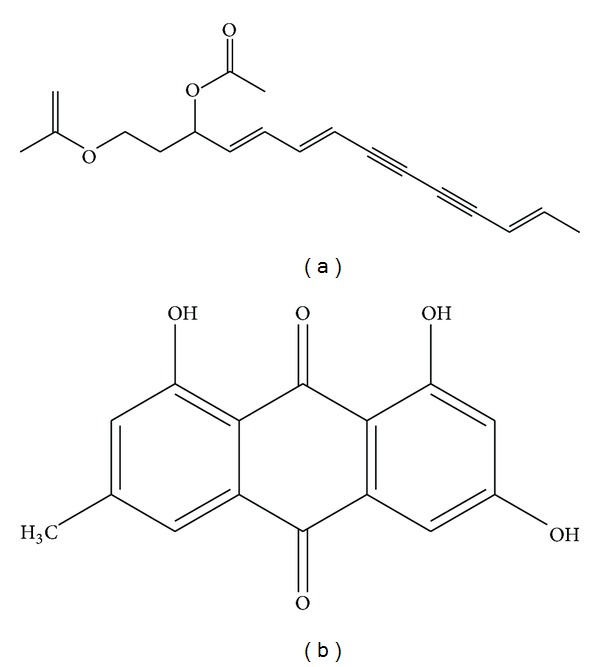
Chemical structures of (4E,6E,12E)-tetradecatriene-8,10-diyne-1,3-diyl diacetate (a) and Emodin (b).
HPLC grade acetonitrile was purchased from Fisher Scientific Company (New Jersey, USA) and Pure water was supplied by Wahaha Company (Hangzhou, China). Analytical grade ethanol and chloroform were from Baierdi Company (Beijing, China). Atractylodis Rhizoma was identified by Professor Li Feng (Liaoning University of TCM) according to the standards of Chinese Pharmacopoeia 2010. The processed Atractylodis Rhizoma comes from the same batch Atractylodis Rhizoma. The herb was stored in a cool and dry place.
2.2. Preparation of Atractylodis Rhizoma Solution
Atractylodis Rhizoma (50 g) was crushed into powder and soaked into 600 mL of 80% ethanol for 24 h and then percolated at 2 mL·min−1, and Ethanol was evaporated to near dryness under reduced pressure to get the residue. Distilled water was added into the residue and then vortexed for 10 min. The final concentration of Atractylodis Rhizoma solution was 2 g·mL−1 [9]. The sample was stored in dry and dark place before use.
2.3. Apparatus and HPLC Conditions
The liquid chromatographic system consisted of an LC-10 AD pump (Shimadzu, Kyoto, Japan) with a 20 μL loop (Cotata, CA, USA) and an SPD-10A ultraviolet-visile detector (Shimadzu, Kyoto, Japan). A LC-10 AD workstation was used for data acquisition. A Diamonsil C18 analytical column (250 × 4.6 mm; 5 μm) from Dikma Technologies (Dalian, China) was used. The mobile phase consisted of acetonitrile and 0.1% phosphoric acid water (60 : 40, v/v) at a flow rate of 1 mL·min−1. The detection wavelength was set at 336 nm. All the measurements were performed at room temperature, and the injection volume was 20 μL.
2.4. Preparation of Standard Solution and Quality Control Samples
Stock solutions of (4E,6E,12E)-tetradecatriene-8,10-diyne-1,3-diyl diacetate and IS with concentrations of 0.143 mg·mL−1 and 0.0504 mg·mL−1, respectively, were prepared in methanol and stored at −20°C and dark place until use. When we used the standard solution, the working concentration of (4E,6E,12E)-tetradecatriene-8,10-diyne-1,3-diyl diacetate and IS were 286 μg·L−1 and 5.04 μg·L−1, respectively. Calibration standards of (4E,6E,12E)-tetradecatriene-8,10-diyne-1,3-diyl diacetate were prepared by spiking the appropriate amount of the working solutions into 200 μL blank rat plasma or tissue homogenates. To plasma samples, the final concentrations of calibration standard samples were 0.003575, 0.00715, 0.0143, 0.03575, 0.0715, 0.143, and 0.2145 μg·mL−1. Quality control (QC) samples were prepared at low, medium, and high concentrations of 0.00375, 0.03575, and 0.0715 μg·mL−1. To tissue homogenates, the final concentrations of calibration standard samples were 0.00143, 0.003575, 0.00715, 0.0143, 0.0286, 0.03575, and 0.0715 μg·mL−1. Quality control (QC) samples were prepared at low, medium, and high concentrations of 0.00375, 0.03575, and 0.0715 μg·mL−1 for tissue homogenates.
2.5. Sample Preparations
For plasma samples, the 200 μL of rat plasma was mixed with 20 μL IS (0.00504 mg·mL−1). After protein was precipitated with 1,000 μL of acetonitrile in 1.5 mL polypropylene tube by vortexing for 2 min, the sample was centrifuged at 10,000 rpm·min−1 for 5 min. The supernatant was transferred into a 5.0 mL tube and added with 1,000 μL of chloroform, extract and the under organic phase was transferred to another tube and evaporated to dryness at 40°C with nitrogen. The resulting extract was dissolved in 50 μL of methanol, and vortex mixed for 2 min. After centrifugation at 10,000 rpm·min−1 for 5 min, 20 μL supernatant was injected for analysis [10–12]. For tissue homogenate, each weighed tissue sample was thawed and the homogenized in ice-cold physiological saline (2 mL). Then a 200 μL of tissue homogenate was taken and processed further like the plasma samples.
2.6. Method Validation
2.6.1. Specificity
The selectivity of the method was demonstrated by comparing chromatograms of blank plasma samples and tissue homogenate (without IS) obtained from rats and plasma samples and tissue homogenate spiked with the analytes and IS and plasma samples and tissue homogenate after an oral dose. All blank plasma samples and tissue homogenates were prepared and analyzed to ensure the absence of interfering peaks.
2.6.2. Calibration Procedure
The linearity of the method was assessed by plotting calibration curves in plasma at seven concentration levels in triplicate on three consecutive days. The lower limit of quantification (LLOQ) was defined as the lowest concentration of the calibration curve that was measured with accuracy and precision by analyzing samples in six replicates at the concentration of 0.00143 μg·mL−1 for (4E,6E,12E)-tetradecatriene-8,10-diyne-1,3-diyl diacetate.
2.6.3. Accuracy and Precision
Intraday precision and accuracy were evaluated by analysis of the three QC samples with six determinations per concentration at the same day, whilst the interday precision and accuracy were measured over three consecutive days. The precision was defined as the relative standard deviation (RSD%), while accuracy was determined by calculating the percentage deviation observed in the analysis of QC samples and expressed by relative error (RE%). The accepted criteria for the data were that the precision and accuracy should not exceed 15%, except at the LLOQ, where it should not exceed 20%.
2.6.4. Extraction Recovery and Stability
The extraction recoveries of (4E,6E,12E)-tetradecatriene-8,10-diyne-1,3-diyl diacetate were determined at low, medium, and high level of QC samples. Recoveries were calculated by comparing the observed peak area ratios in biosamples to those nonprocessed standard solutions at the same concentrations. The recovery of IS was determined in the same way at the concentration of 0.00504 mg·mL−1.
The stability of (4E,6E,12E)-tetradecatriene-8,10-diyne-1,3-diyl diacetate in plasma and tissue was determined under different storage or handling conditions. Short-term stability was assessed by analyzing QC samples kept at room temperature for 8 h. Freeze-thaw stability was evaluated at three consecutive freeze-thaw cycles. Long-term stability was studied by assaying samples following a period of 10 days of storage at −20°C.
2.7. Applications in Pharmacokinetic Studies
All the studies on animals were in accordance with the Guidelines for the Care and Use of Laboratory Animals. Healthy Sprague-Dawley rats (250 ± 20 g) were purchased from The Medical University of Dalian (Dalian, China) and acclimated in the laboratory for one week before to the experiments. Rats for oral ingestion were fasted for 12 h with free access to water. Rats were oral administration raw and processed Atractylodis Rhizoma at a single dose of 40 g·kg−1, respectively.
For plasma samples, twelve rats were randomly assigned to two groups for pharmacokinetic investigation (n = 6 per group). The blood sample (0.5 mL) was collected at 0, 0.17, 0.33, 0.5, 1, 2, 3, 4, 6, 8, 12, and 24 h. All samples were immediately transferred into heparinized tubes and centrifuged for 5 min at 10,000 rpm·min−1. The supernatant was stored at −20°C and dark place until use.
2.8. Tissue Distribution Study
For tissue distribution study, forty-eight rats were divided into eight groups (n = 6 per group) randomly.
After oral administration four groups rats raw Atractylodis Rhizoma at a single dose of 40 g·kg−1 and the other four groups rats processed Atractylodis Rhizoma at a single dose of 40 g·kg−1. Heart, liver, spleen, lung, kidney, stomach, small intestine, and large intestine were collected at 0.5, 2, 4, and 8 h. Tissue samples were weighed 0.1 g rapidly, rinsed with physiological saline to remove the blood or content, blotted on filter paper, and then stored at −20°C and dark place until use.
2.9. Statistical Analysis
HPLC analysis procedure was applied to analyze plasma concentration-time profiles of (4E,6E,12E)-tetradecatriene-8,10-diyne-1,3-diyl diacetate. Data was processed by noncompartmental method using Drug and Statistics (DAS) 2.0 software package (Chinese Pharmacological Society, Shanghai, China).
3. Results and Discussion
3.1. Method Validation
3.1.1. Specificity
The representative chromatograms for determination of (4E,6E,12E)-tetradecatriene-8,10-diyne-1,3-diyl diacetate in plasma and tissues are shown in Figure 2. The retention time of Emodin (IS) was about 16.30 min and (4E,6E,12E)-tetradecatriene-8,10-diyne-1,3-diyl diacetate was about 30.45 min. It was indicated that analytes and IS were well separated and no interferences were detected from endogenous substances or metabolites.
Figure 2.

Chromatograms of blank plasma (a); blank plasma spiked with (4E,6E,12E)-tetradecatriene-8,10-diyne-1,3-diyl diacetate 20 μL (0.143 μg·mL−1) and IS 20 μL (0.00504 mg·mL−1) (b); rat plasma sample (4 h) after oral administration of raw Atractylodis Rhizoma 40 g·kg−1 (c); rat plasma sample (4 h) after oral administration of processed Atractylodis Rhizoma 40 g·kg−1 (d); Chromatograms of blank tissue homogenate (e); blank tissue homogenate with (4E,6E,12E)-tetradecatriene-8,10-diyne-1,3-diyl diacetate 20 μL (0.286 μg·mL−1) and IS 20 μL (0.00504 mg·mL−1) (f); spleen sample (2 h) after oral administration of raw Atractylodis Rhizoma 40 g·kg−1 (g); spleen sample (2 h) after oral administration of processed Atractylodis Rhizoma 40 g·kg−1 (h).
3.1.2. Linearity of Calibration Curve and Lower Limit of Quantification
The calibration curves were linear over the concentration range of 0.003575–0.2145 μg·mL−1 in rat plasma and 0.00143–0.0715 μg·mL−1 in tissue homogenates by weighted (1/x 2) linear least-squares regression method. The correlation coefficient values of the calibration curves were over 0.9900. The RE of the back-calculated values of the standards from their nominal values were constantly within 15% for all values, including the LLOQ. The LLOQ measurement showed the respective averages 0.003575 μg·mL−1 with RSD 7.68% for rat plasma and 0.00143 μg·mL−1 with RSD 8.68% for tissue homogenates. Typical linear regression equations, correlation coefficients in plasma and each tissue were listed in Table 1.
Table 1.
The Linear regression analysis of (4E,6E,12E)-tetradecatriene-8,10-diyne-1,3-diyl diacetate in rat plasma and tissues (n = 7).
| Sample | Calibration curves | r | Linear range |
|---|---|---|---|
| Plasma | Y = 23.628X + 0.044 | 0.9950 | 0.00361–0.18814 |
| Heart | Y = 13.259X + 0.031 | 0.9958 | 0.00149–0.07322 |
| Liver | Y = 14.351X + 0.064 | 0.9951 | 0.00144–0.06925 |
| Spleen | Y = 12.936X + 0.028 | 0.9951 | 0.00146–0.07431 |
| Lungs | Y = 14.704X + 0.059 | 0.9956 | 0.00143–0.07872 |
| Kidney | Y = 12.936X + 0.028 | 0.9951 | 0.00143–0.06716 |
| Stomach | Y = 15.161X + 0.012 | 0.9964 | 0.00143–0.06786 |
| Large intestine | Y = 11.271X + 0.019 | 0.9952 | 0.00146–0.08179 |
| Small intestine | Y = 12.956X + 0.037 | 0.9985 | 0.00144–0.07339 |
3.1.3. Precision and Accuracy
The intraday and interday precision and accuracy were assessed by analyzing six aliquots of low, medium, and high concentration samples. The intraday precision of (4E,6E,12E)-tetradecatriene-8,10-diyne-1,3-diyl diacetate in rat plasma and tissues ranged between 1.83 and 6.71% with RE of −14.47~−7.81% and the interday precision ranged between 1.57 and 8.68% with RE of −14.38~−5.13%.
3.1.4. Recovery and Stability
The extraction recoveries of (4E,6E,12E)-tetradecatriene-8,10-diyne-1,3-diyl diacetate ranged from 86.6% to 91.6% in plasma and tissue samples and the method recovery ranged from 85.6% to 94.9%, while the recovery of IS was above 80%. These data indicated that the biosample preparation procedure was satisfied and can achieve the acceptable extraction recovery. Stability of analytes showed no significant sample loss over 12 h at room temperature, three freeze-thaw cycles, and 10 days storage condition. The RE of three conditions were within ±15%.
3.2. Pharmacokinetics of (4E,6E,12E)-Tetradecatriene-8,10-diyne-1,3-diyl Diacetate in Rats
The assay was applied to a preliminary pharmacokinetic experiment after oral administration of 40 g·kg−1 raw and processed Atractylodis Rhizoma to rats, respectively. Mean concentration-time curves were shown in Figures 3 and 4. The pharmacokinetic parameters were shown in Table 2.
Figure 3.
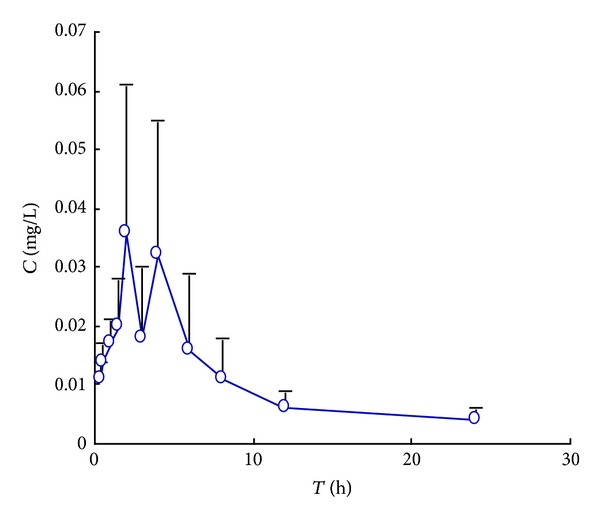
Mean plasma concentration-time curve of (4E,6E,12E)-tetradecatriene-8,10-diyne-1,3-diyl diacetate after oral administration of raw Atractylodis Rhizoma (40 g·kg−1) to rats. (mean ± SD, n = 6).
Figure 4.
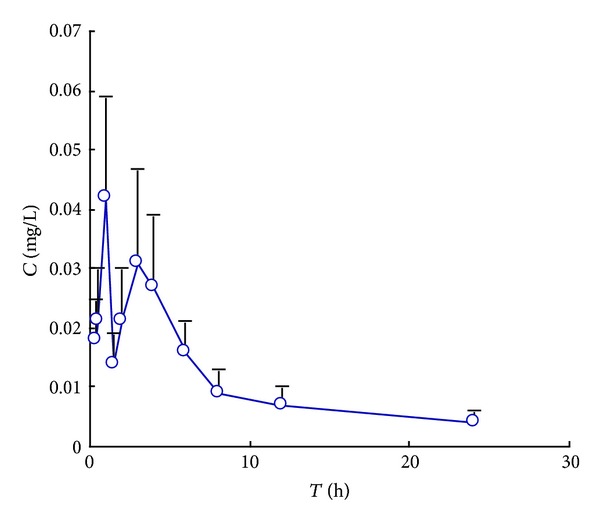
Mean plasma concentration-time curve of (4E,6E,12E)-tetradecatriene-8,10-diyne-1,3-diyl diacetate after oral administration of processed Atractylodis Rhizoma (40 g·kg−1) to rats. (mean ± SD, n = 6).
Table 2.
The pharmacokinetic parameters of (4E,6E,12E)-tetradecatriene-8,10-diyne-1,3-diyl diacetate of raw and processed AtractylodisRhizoma at a dose of 40 g·kg−1 to rats, respectively (n = 6).
| Parameters | Raw | Processed |
|---|---|---|
| AUC(0-t) (mg·h·L−1) | 0.260 ± 0.137 | 0.265 ± 0.100 |
| AUC(0-∞) (mg·h·L−1) | 0.317 ± 0.157 | 0.303 ± 0.111 |
| MRT(0-t) (h ) | 7.706 ± 0.888 | 7.384 ± 0.86 |
| MRT(0-t) (h) | 14.86 ± 6.813 | 12.22 ± 3.364 |
| t 1/2z (h) | 9.905 ± 7.382 | 8.047 ± 3.347 |
| T max (h) | 2.333 ± 0.816 | 1.000 ± 0.817 |
| C max (mg·L−1) | 0.038 ± 0.024 | 0.042 ± 0.017 |
A significant result of this study is finding that (4E,6E,12E)-tetradecatriene-8,10-diyne-1,3-diyl diacetate showed double peaks after oral administration, which demonstrated that a hepatoenteral circulation may exist. For raw Atractylodis Rhizoma the absorption peaks in rat plasma was at 2 h and 4 h, respectively and the C max was 38 ± 24 μg·L−1. And for processed Atractylodis Rhizoma the absorption peaks was at 1 h and 3 h, respectively and the C max is 42 ± 17 μ·gL−1. So the time of absorption peak was 1 hour in advance and the concentration of rat plasma was increased after processing. The value of T max and T 1/2 indicated that the (4E,6E,12E)-tetradecatriene-8,10-diyne-1,3-diyl diacetate was rapidly distributed but slowly eliminated. The reason for this result also requires further study.
3.3. Tissue Distribution Study
The tissue concentrations of (4E,6E,12E)-tetradecatriene-8,10-diyne-1,3-diyl diacetate determined at 0.5, 2, 4, and 8 h after oral administration raw and processed Atractylodis Rhizomaat a dose of 40 g·kg−1are shown in Table 3 and Figures 5 and 6, which indicated that (4E,6E,12E)-tetradecatriene-8,10-diyne-1,3-diyl diacetate could be distributed to all collected tissues, for raw Atractylodis Rhizoma, the concentrations of (4E,6E,12E)-tetradecatriene-8,10-diyne-1,3-diyl diacetate in tissue were distributed, followed by spleen, liver, small intestine, heart, stomach, large intestine, kidney, and lungs; for processed Atractylodis Rhizoma, the concentrations of (4E,6E,12E)-tetradecatriene-8,10-diyne-1,3-diyl diacetate in tissue were distributed, followed by spleen, heart, kidney, liver, lungs, stomach, small intestine, large intestine. Relatively, the concentrations of (4E,6E,12E)-tetradecatriene-8,10-diyne-1,3-diyl diacetate of raw and processed Atractylodis Rhizoma was higher in the spleen. And the concentrations in the spleen were increased after stir-frying with bran. The results showed that processing can promote the rate of absorption of (4E,6E,12E)-tetradecatriene-8,10-diyne-1,3-diyl diacetate.
Table 3.
The tissue concentrations of (4E,6E,12E)-tetradecatriene-8,10-diyne-1,3-diyl diacetate after oral administration raw and processed Atractylodis Rhizoma at a dose of 40 g·kg−1 to rats, respectively (μg/g).
| Tissues | 0.5 h | 2 h | 4 h | 8 h | ||||
|---|---|---|---|---|---|---|---|---|
| Raw | Processed | Raw | Processed | Raw | Processed | Raw | Processed | |
| Heart | 125.31 | 137.68 | 128.97 | 244.30 | 77.35 | 61.62 | 35.94 | 30.56 |
| Liver | 80.37 | 158.37 | 155.10 | 208.56 | 158.07 | 173.38 | 115.10 | 128.98 |
| Spleen | 170.71 | 119.41 | 253.18 | 292.69 | 186.45 | 204.92 | 17.34 | 30.66 |
| Lung | 69.35 | 70.01 | 46.54 | 174.26 | 84.79 | 100.26 | 40.20 | 60.61 |
| Kidney | 108.76 | 105.54 | 76.15 | 242.21 | 81.83 | 84.78 | 24.51 | 21.12 |
| Stomach | 112.31 | 107.95 | 109.77 | 122.96 | 65.22 | 78.53 | 43.17 | 59.93 |
| Large Intestine | 20.33 | 30.68 | 79.02 | 54.78 | 112.25 | 143.34 | 166.77 | 176.64 |
| Small Intestine | 91.25 | 106.29 | 139.04 | 115.53 | 191.22 | 159.02 | 44.91 | 54.78 |
Figure 5.
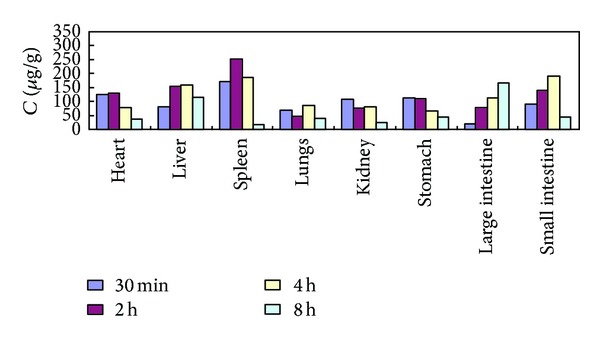
The concentration-time profile of (4E,6E,12E)-tetradecatriene-8,10-diyne-1,3-diyl diacetate in tissues after oral administration of raw Atractylodis Rhizoma at a dose of 40 g·kg−1 to rats (n = 6).
Figure 6.
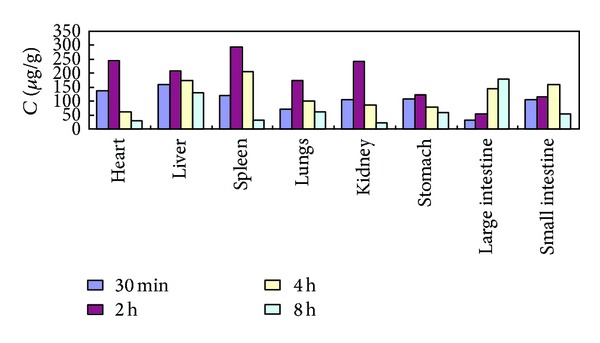
The concentration-time profile of (4E,6E,12E)-tetradecatriene-8,10-diyne-1,3-diyl diacetate in tissues after oral administration of processed Atractylodis Rhizoma at a dose of 40 g·kg−1 to rats (n = 6).
4. Conclusion
A simple, specific, and rapid RP-HPLC method with UV detection for quantification of (4E,6E,12E)-tetradecatriene-8,10-diyne-1,3-diyl diacetate in rat plasma has been developed for the first time. It has been successfully applied to a preliminary pharmacokinetic and tissue distribution study of (4E,6E,12E)-tetradedecatriene-8,10-diyne-1,3-diyl diacetate after oral administration of 40 g·kg−1 raw and processed Atractylodis Rhizoma, respectively. We found that the T max have significant difference (P < 0.05), and other pharmacokinetics have no significant difference after using Student's t-test. The result indicated that processing can promote and accelerate the absorption and the concentration of (4E,6E,12E)-tetradecatrinen-8,10-diyne-1,3-diyl diacetate is the highest in the spleen Which proved that the traditional theory of processing Atractylodis Rhizoma can increase its function of tonifying the spleen.
Acknowledgment
This project was supported by grants from the National Natural Science Foundation of China (no. 81202919) and the Special Scientific Research for Traditional Chinese Medicine of State Administration of Traditional Chinese Medicine of China (no. 20110700712).
Conflict of Interests
The authors declare that they have no conflict of interests.
References
- 1.Chinese Pharmacopoeia Committee. Pharmacopeia of People's Republic of China. Beijing, China: Chinese Medicine Science and Technology; 2010. [Google Scholar]
- 2.Pu SS, Pu ZX, Yuan ST. Study on processing historical evolution of Atractylodes Lancea . Chinese Pharmaceutical Journal. 2000;35(11):87–91. [Google Scholar]
- 3.Liu YJ, Xu LY, Yuan ST. Study on processing technology of stir-frying atractylodes with wheat bran. Chinese Journal of Hospital Pharmacy. 2009;29(15):1267–1268. [Google Scholar]
- 4.Resch M, Steigel A, Chen Z-L, Bauer R. 5-lipoxygenase and cyclooxygenase-1 inhibitory active compounds from Atractylodes lancea. Journal of Natural Products. 1998;61(3):347–350. doi: 10.1021/np970430b. [DOI] [PubMed] [Google Scholar]
- 5.Resch M, Heilmann J, Steigel A, Bauer R. Further phenols and polyacetylenes from the rhizomes of Atractylodes lancea and their anti-inflammatory activity. Planta Medica. 2001;67(5):437–442. doi: 10.1055/s-2001-15817. [DOI] [PubMed] [Google Scholar]
- 6.Fang CW, Fan M, Liu SJ, Pan LB. Simultaneous determination of three acetylenic polyethylene components in atractylodes lancea. Journal of Chinese Medicinal Materials. 2010;33(6):932–934. [Google Scholar]
- 7.Liu YQ, Jia TZ, Cai Q. Determination of three components in stir-frying Atractylodes Rhizoma with and without bran by HPLC. Chinese Traditional Patent Medicine. 2013;35(1):131–135. [Google Scholar]
- 8.Chen YM, Chou GX, Wang ZT. Simultaneous determination of polyacetylene components in Cangzhu by reversed-phase high performance liquid chromatography. Chinese Journal of Chromatography. 2007;25(1):84–87. [PubMed] [Google Scholar]
- 9.Zhang YS, Wang ZM, Zhu JJ, Chen B, Li YQ. Determination of atractylodin in rat plasma by HPLC-UV method and its application to a Pharmacokinetic Study. Journal of Liquid Chromatography and Related Technologies. 2012;35(6):778–787. [Google Scholar]
- 10.Liu DF, Zhang L, Chen T. Pharmacokinetics Study on Paeoniflorin in Silli San. China Jornal of Experimental Traditional Medical Formulae. 2005;11(2):36–38. [Google Scholar]
- 11.Chen S-Z, Jia H, Wu Y-H, Wang H. Pharmacokinetics of honokiol in rats. Journal of Peking University. 2004;36(1):41–44. [PubMed] [Google Scholar]
- 12.Li JM, Huo SX, Gao Wu PP, Pang XM, Lin Q, Yan M. Pharmacokinetics study of galangin in rats. Chinese Pharmacological Bulletin. 2012;28(9):1307–1310. [Google Scholar]


